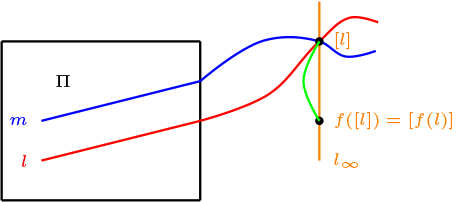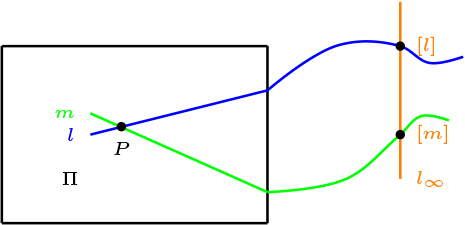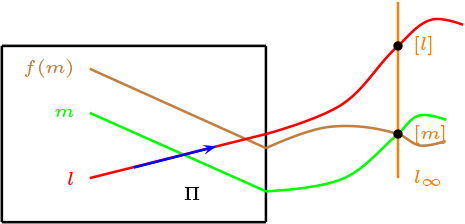Sea \(t(x,y)= (x+a,y+b)\text{,}\) la traslación dada y definimos
\begin{equation*}
\mathcal{L}' = \{U\leq \mathbb{K}^3\ | \ dim U=1 \wedge \Pi_1 \cap U \neq \varnothing \} .
\end{equation*}
Trasladando a \(\Pi_1\) obtenemos
\begin{equation*}
\begin{array}{rccc}
\overline{t}: \amp\mathcal{L}' \amp \rightarrow \amp \mathcal{L}' \\
\amp \lt(x,y,1)\gt \amp \rightsquigarrow \amp \lt (x+a,y+b,1)\gt
\end{array}
\end{equation*}
Dada la recta que pasa por los puntos \((c,d), (u,v)\text{,}\) luego la recta que une los puntos en forma vectorial es \(l= \lt c-u,d-v\gt +(u,v)\text{,}\) y el correspondiente representante en plano \(\Pi_0\) es
\begin{equation*}
l'= \lt c-u,d-v,0)\gt .
\end{equation*}
De esta manera tenemos que la recta que pasa por \(t(c,d), t(u,v)\text{,}\) esta dada por
\begin{equation*}
t(l)= \lt c-u,d-v\gt +(u+a,v+b),
\end{equation*}
la representante en plano \(\Pi_0\) es \(l'= \lt c-u,d-v,0)\gt \)
\begin{equation*}
\begin{array}{rccc}
\overline{t}: \amp\mathcal{L} \amp \rightarrow \amp \mathcal{L} \\
\amp \lt (x,y,1)\gt \amp \rightsquigarrow \amp \lt (x+a,y+b,1)\gt \\
\amp \lt (x,y,0)\gt \amp \rightsquigarrow \amp \lt (x,y,0)\gt
\end{array}
\end{equation*}
extendiendo linealmente los elementos de la recta, obtenemos que \(\overline{t}(x,y,z)= (\alpha x +az, \beta y+bz, \gamma z)\text{,}\) que al restringir tenemos que \(\overline{t}|_\Pi =t\text{,}\) luego
\begin{equation*}
\overline{t}(x,y,z)= ( x +az, y+bz, z)
\end{equation*}



